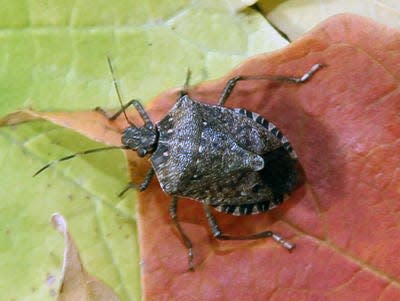You're gonna love this smell-free way to get rid of stink bugs

This is the time of the year when you may find unwanted guests getting into your home. The frosty nights signal home-invading insects – like the brown marmorated stink bug – to find a warm place to stay for the winter.
Stink bugs are non-native insects. They came from eastern Asia, most likely by stowing away in a shipping container. They can be a threat to fruit crops because they feed on and damage the fruit as it develops. They also feed on ornamental plants. So far, the populations have remained low enough that damage to ornamental plants is minimal. Control has not been necessary in residential areas.
How do stink bugs get into your house?
Stink bugs do not bite or hurt humans or our pets. For most people, the problem with stink bugs is they are ugly and give people the creeps. For the last few weeks, the bugs have been trying, with varying success, to get into our homes. They need a warm place in which to survive the winter, but they do not necessarily need to live indoors. They can survive the winter in dry protected areas such as in a wood pile.
They may be ugly, but they are not dumb. They prefer to winter indoors where they know it is nice and warm. They know the odds of survival are much greater inside.

To get inside a home, some will take the easy route and just go in through the front door if it is left open long enough. They see an opportunity and fly right in. This is most likely to happen in the evening because stink bugs are attracted to light.
They will also crawl into houses through cracks and crevices, frequently around windows. They can come in through holes in the screens. Again, they are attracted to the light coming through the windows. You can reduce the attraction by keeping unneeded lights turned off. If they are getting in, you also need to seal up the places where they are getting in. If they are getting in, other insects are, too.
These insects have an interesting ability, given to them by nature, to survive the winter. The life span of a stink bug is three to four months. Knowing this, you would think the majority would die during the winter. They don't though, because during the winter months, stink bugs go into diapause. This is a hibernation-like state in which they remain inactive and don't eat.
How do you get rid of stink bugs?
If you encounter stink bugs in your house, don't try to kill them by smashing them. If you do, you'll find out why they are called "stink bugs." Stink bugs get their name from the unpleasant odor they produce when they are threatened. Scientists think this odor helps protect the bugs against predators.
You may see stink bugs gathering in large numbers on the side of your house or on the screens. If you can get to them, the best way to remove them is with a vacuum cleaner. You can also do this when you see them inside. With this method, they will be inside of the vacuum before they can let their stink out. Empty the container from the vacuum outside to keep the smell out of the house.

Next up: Treat your Boxwoods now!
Also, before we get much deeper into fall, I want to remind you that this is the time you can and should be treating your Boxwoods with a systemic insecticide. Boxwoods this past season suffered a tremendous amount of damage due to a combination of severe freezing temperatures from one cold night last December, followed by seasonal insect damage in the spring.
These insecticides are easily applied as a soil drench to the roots of the Boxwoods. Applying them now will help avoid insect problems in the next growing season.
This article originally appeared on Cincinnati Enquirer: You're gonna love this smell-free way to get rid of stink bugs
